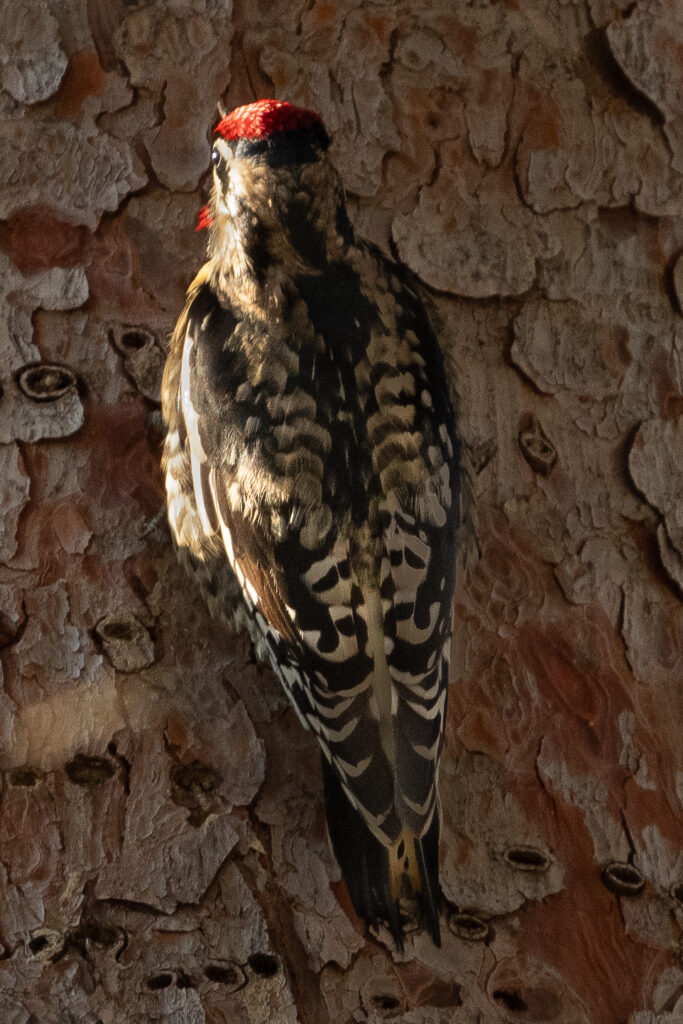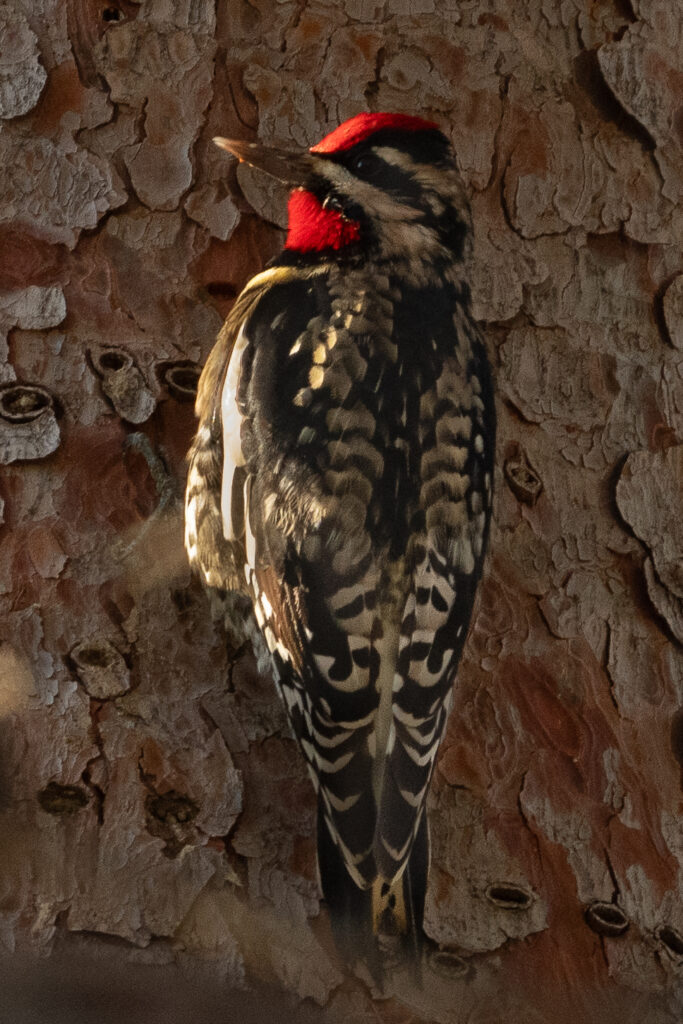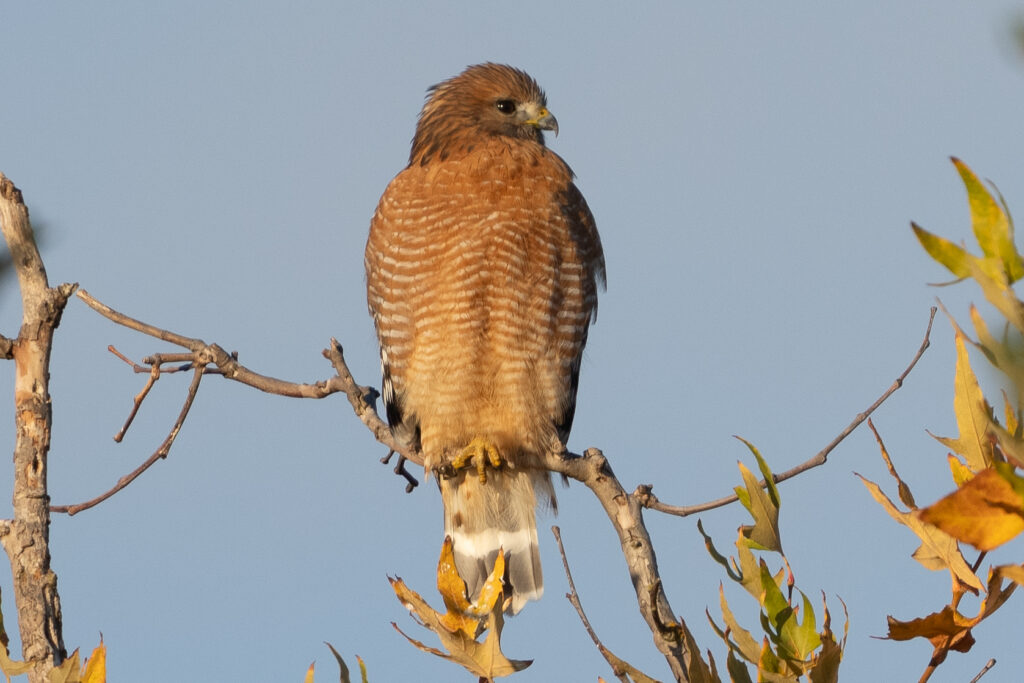According to the Peterson Reference Guide to Woodpeckers, the Yellow-bellied Sapsucker (Sphyrapicus varius) is “the most migratory woodpecker in the world, breeding as far north as e. AK and the northern boreal forest, and wintering as far south as Panama and the Caribbean.” That said, they are fairly infrequent wintering birds here on California’s Central Coast, so when I was out birding the day before Thanksgiving this year, I had to do quite a bit of research to be sure the bird I saw was, in fact, a Yellow-bellied Sapsucker.
The experts at eBird haven’t yet confirmed the sighting, although I submitted five quite poor photos as evidence. I might have been able to get better shots, but, like Coleridge being interrupted by the importunate visitor from Porlock, I was interrupted: I had to stop shooting to say hi to the neighbors who were coming up behind me on the easement. At first I was worried that they were the actual property owners, because the easement runs along the perimeter of a property that recently sold, and I wasn’t sure the new owners were used to a weirdo with binoculars and a giant telephoto lens meaning no harm. But they were just some other neighbors—in fact, they were wondering whether I was the property owner! Unfortunately, when I turned my attention back to the bird, it had either flown or moved out of sight around the trunk. Sigh.
Distinguishing between three of the four North American sapsucker species is a bit fraught, because the various superspecies of Yellow-bellied, Red-naped, and Red-breasted Sapsuckers all overlap substantially in plumage, and they hybridize as well. The confusion is evident even in the taxonomic names of the species. Spencer Baird gave the genus its name in 1858. The first part of the name, Sphyra, comes from the ancient Greek sphura for “hammer”; the rest, picus, is from the ancient Greek pikos, “hammer.”
All three of these species have a broad white stripe in the wing, so it’s pretty easy to know when you have a sapsucker. (Williamson’s, the fourth Sphyrapicus woodpecker, also has a white wing stripe, but the overall bird looks so different from the other three that it’s almost impossible to confuse it.) By range, birders in the East can pretty much stop there: any sapsucker in the Atlantic states is going to be a Yellow-bellied.
But here in the West, and barring Williamson’s, which is distinctive, there are three possibilities to sort through.
- Yellow-bellied Sapsuckers have a solid black malar stripe that completely borders a red (in males) or white (in females) throat, and a solid white stripe on the back of the head. Males also have a bit of a white “strap” that looks from the side like a necklace; this is sometimes yellow (this strap isn’t mentioned often as a field mark, so it might not be reliable).
- Red-naped Sapsuckers (S. nuchalis, from modern Latin for “of the nape”–if you remember your college anatomy classes, “nuchal” means “neck-al”) have a thin black malar stripe that is usually invaded by the red throat patch of the male and, as in the common name, the white on the back/nape of the head has some (or a lot of) red in it. The white “strap” is rarely illustrated with any yellow in it.
- Red-breasted Sapsuckers (S. ruber, from the Latin for “red”) have a solid red head except for black lores and whitish nasal tufts, so a good head shot will distinguish this species from the other two fairly quickly.
I’ve seen Red-breasted in the neighborhood twice in all the years I’ve been birding it (once or twice a year from 2000 to 2023, almost daily since then).
I’ve never seen a Red-naped.
I’ve seen one Yellow-bellied, and it was the day before Thanksgiving, 2024. Here’s a little gallery of it:
The sapsucker was just the rarest find of the morning, though. I also saw a couple of White-tailed Kites, rare but regular visitors year-round, and I got some decent views of our resident Red-tailed and Red-shouldered Hawks, along with our overwintering Savannah Sparrows. One of the birdiest walks around town this month!












